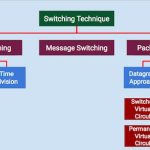Special Instructional Objectives:
· On completion, the student will be able to:
· Explain how High-Level Data Link Control (HDLC) works
· Explain how piggybacking is done in HDLC
· Explain how data transparency is maintained in HDLC
Introduction
HDLC is a bit-oriented protocol. It was developed by the International Organization for Standardization (ISO). It falls under the ISO standards ISO 3309 and ISO 4335. It specifies a packetization standard for serial links. It has found itself being used throughout the world. It has been so widely implemented because it supports both half-duplex and full-duplex communication lines, point-to-point (peer to peer) and multi-point networks, and switched or non-switched channels. HDLC supports several modes of operation, including a simple sliding-window mode for reliable delivery. Since Internet provides retransmission at higher levels (i.e., TCP), most Internet applications use HDLC’s unreliable delivery mode, Unnumbered Information.
Other benefits of HDLC are that the control information is always in the same position, and specific bit patterns used for control differ dramatically from those in representing data, which reduces the chance of errors. It has also led to many subsets. Two subsets widely in use are Synchronous Data Link Control (SDLC) and Link Access Procedure-Balanced (LAP-B).
In this lesson we shall consider the following aspects of HDLC:
· Stations and Configurations
· Operational Modes
· Non-Operational Modes
· Frame Structure
· Commands and Responses
· HDLC Subsets (SDLC and LAPB)
HDLC Stations and Configurations
HDLC specifies the following three types of stations for data link control:
· Primary Station
· Secondary Station
· Combined Station
Primary Station
Within a network using HDLC as its data link protocol, if a configuration is used in which there is a primary station, it is used as the controlling station on the link. It has the responsibility of controlling all other stations on the link (usually secondary stations). A primary issues commands and secondary issues responses. Despite this important aspect of being on the link, the primary station is also responsible for the organization of data flow on the link. It also takes care of error recovery at the data link level (layer 2 of the OSI model).
Secondary Station
If the data link protocol being used is HDLC, and a primary station is present, a secondary station must also be present on the data link. The secondary station is under the control of the primary station. It has no ability, or direct responsibility for controlling the link. It is only activated when requested by the primary station. It only responds to the primary station. The secondary station’s frames are called responses. It can only send response frames when requested by the primary station. A primary station maintains a separate logical link with each secondary station.
Combined Station
A combined station is a combination of a primary and secondary station. On the link, all combined stations are able to send and receive commands and responses without any permission from any other stations on the link. Each combined station is in full control of itself, and does not rely on any other stations on the link. No other stations can control any combined station. May issue both commands and responses. HDLC also defines three types of configurations for the three types of stations. The word configuration refers to the relationship between the hardware devices on a link. Following are the three configurations defined by HDLC:
· Unbalanced Configuration
· Balanced Configuration
· Symmetrical Configuration
Unbalanced Configuration
The unbalanced configuration in an HDLC link consists of a primary station and one or more secondary stations. The unbalanced condition arises because one station controls the other stations. In an unbalanced configuration, any of the following can be used:
· Full-Duplex or Half-Duplex operation
· Point to Point or Multi-point networks
An example of an unbalanced configuration can be found below in Fig.

Unbalanced configuration
Balanced Configuration
The balanced configuration in an HDLC link consists of two or more combined stations. Each of the stations has equal and complimentary responsibility compared to each other. Balanced configurations can use only the following:
· Full – Duplex or Half – Duplex operation
· Point to Point networks
An example of a balanced configuration can be found below in Fig.

Balanced configuration
Symmetrical Configuration This third type of configuration is not widely in use today. It consists of two independent point-to-point, unbalanced station configurations as shown in Fig. In this configuration, each station has a primary and secondary status. Each station is logically considered as two stations.

Symmetric configuration
HDLC Operational Modes
A mode in HDLC is the relationship between two devices involved in an exchange; the mode describes who controls the link. Exchanges over unbalanced configurations are always conducted in normal response mode. Exchanges over symmetric or balanced configurations can be set to specific mode using a frame design to deliver the command. HDLC offers three different modes of operation. These three modes of operations are:
· Normal Response Mode (NRM)
· Asynchronous Response Mode (ARM)
· Asynchronous Balanced Mode (ABM)
Normal Response Mode
This is the mode in which the primary station initiates transfers to the secondary station. The secondary station can only transmit a response when, and only when, it is instructed to do so by the primary station. In other words, the secondary station must receive explicit permission from the primary station to transfer a response. After receiving permission from the primary station, the secondary station initiates its transmission. This transmission from the secondary station to the primary station may be much more than just an acknowledgment of a frame. It may in fact be more than one information frame. Once the last frame is transmitted by the secondary station, it must wait once again from explicit permission to transfer anything, from the primary station. Normal Response Mode is only used within an unbalanced configuration.
Asynchronous Response Mode
In this mode, the primary station doesn’t initiate transfers to the secondary station. In fact, the secondary station does not have to wait to receive explicit permission from the primary station to transfer any frames. The frames may be more than just acknowledgment frames. They may contain data, or control information regarding the status of the secondary station. This mode can reduce overhead on the link, as no frames need to be transferred in order to give the secondary station permission to initiate a transfer. However, some limitations do exist. Due to the fact that this mode is asynchronous, the secondary station must wait until it detects and idle channel before it can transfer any frames. This is when the ARM link is operating at half-duplex. If the ARM link is operating at full duplex, the secondary station can transmit at any time. In this mode, the primary station still retains responsibility for error recovery, link setup, and link disconnection.
Synchronous Balanced Mode
This mode is used in case of combined stations. There is no need for permission on the part of any station in this mode. This is because combined stations do not require any sort of instructions to perform any task on the link.
Normal Response Mode is used most frequently in multi-point lines, where the primary station controls the link. Asynchronous Response Mode is better for point-to-point links, as it reduces overhead. Asynchronous Balanced Mode is not used widely today. The “asynchronous” in both ARM and ABM does not refer to the format of the data on the link. It refers to the fact that any given station can transfer frames without explicit permission or instruction from any other station.
HDLC Non-Operational Modes
HDLC also defines three non-operational modes. These three non-operational modes are:
· Normal Disconnected Mode (NDM)
· Asynchronous Disconnected Mode (ADM)
· Initialization Mode (IM)
The two disconnected modes (NDM and ADM) differ from the operational modes in that the secondary station is logically disconnected from the link (note the secondary station is not physically disconnected from the link). The IM mode is different from the operations modes in that the secondary station’s data link control program is in need of regeneration or it is in need of an exchange of parameters to be used in an operational mode.


